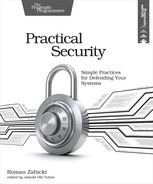Windows Users
We’re going to start out with some foundational Windows concepts before we move into best practices. Let’s start with users. There are two main types of interactive user accounts in Windows—administrators and standard users. Administrators are able to install software and make significant changes to the system. Standard users don’t have these permissions but are able to run installed software.
There is one other kind of user, but it’s not an interactive user. It’s called SYSTEM and it’s the user that does work on behalf of Windows itself. Because it works on behalf of the operating system, it has complete permissions to everything on that computer. We’ll come back to this a little later in the chapter.
When you have more than a handful of computers on your network, you’ll want some things to be centrally controlled and managed. These would be things like user definition and user credentials (hashed passwords, not plaintext passwords as we saw in Password Storage). In a Windows network, this grouping of computers along with its centralized control systems is called a domain. Users can be defined either on a domain, which means they can log in on computers throughout the domain, or they can be defined locally, which means they can only log in on the one computer they’re defined on.
